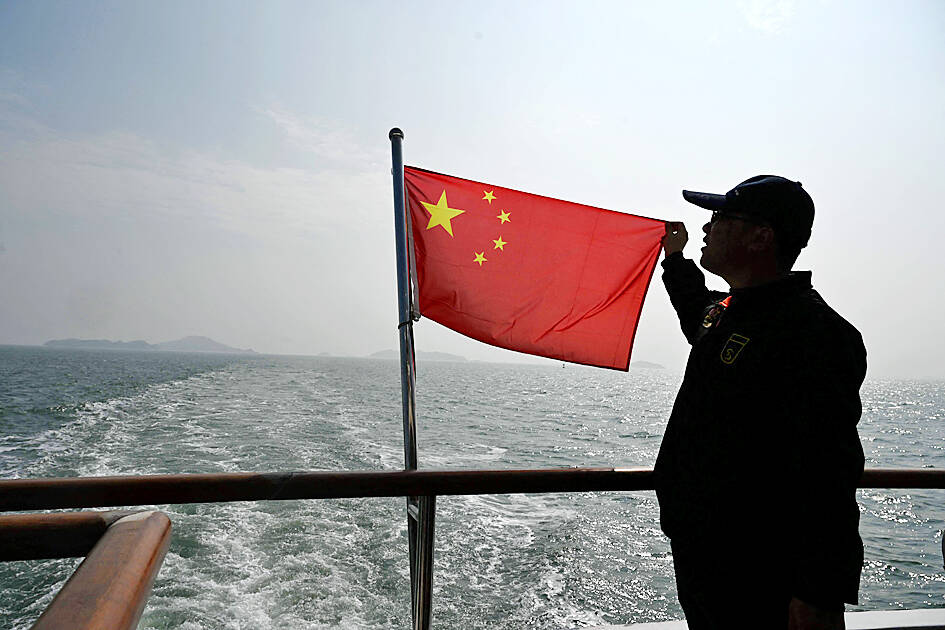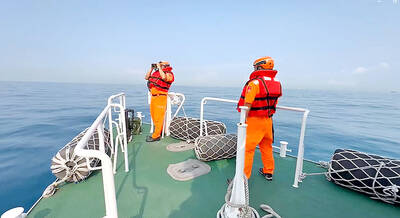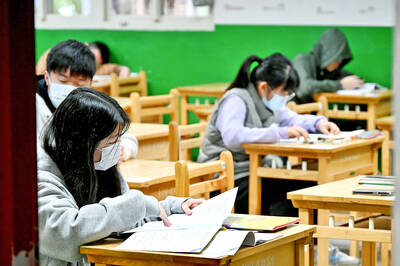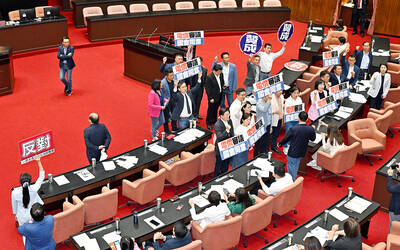Chinese strategies involving economic coercion and psychological warfare against Taiwan are expected to continue following the victory of Democratic Progressive Party (DPP) candidate William Lai (賴清德) in the presidential election, academics said on Saturday.
“We are likely to see a continuation of China’s economic coercion, psychological warfare and gray zone activities,” political scientist Sana Hashmi said.
Grey zone activities, the Indian expert said, mainly involve exacerbating tensions that fall short of military aggression, including military drills, economic coercion, disinformation and information manipulation.

Photo: Greg Baker, AFP
However, a conflict between China and Taiwan or a Chinese invasion is unlikely, the Taiwan-Asia Exchange Foundation fellow said.
With the economic difficulties China currently faces, an incursion is too risky, especially when the outcome of an invasion is uncertain, she said.
Second, Taiwan under Lai would continue to focus on the “status quo,” she said, adding that since there would be continuity in Taiwan’s cross-strait policy, there is no reason for China to attack Taiwan.
Lai has been targeted by the Chinese Nationalist Party (KMT) and Beijing’s propaganda machinery for his past description of himself as a “pragmatic worker for Taiwanese independence,” although he has sought to walk back that characterization in recent months.
The Chinese Communist Party does not trust Lai and therefore in the aftermath of Taiwan’s elections, Beijing could resort to some form of retaliation or intimidation tactics, given that Lai emerged victorious, said Sara Newland, an assistant professor of government at Smith College in the US.
In line with Hashmi’s comments, Newland said that the tactics might take on an economic dimension, such as the reversal of certain benefits provided by the Economic Cooperation Framework Agreement (ECFA).
The ECFA, signed in 2010 when Taiwan was under the KMT administration of then-president Ma Ying-jeou (馬英九), included an “early harvest” list for tariff concessions covering 557 Taiwanese exports to China and 267 Chinese products for export for Taiwan.
The form of retaliation could also manifest in military exercises in proximity to Taiwan or the adoption of diplomatic measures, such as attempting to win over some of Taiwan’s remaining diplomatic allies, Newland said.
Over the longer term, it is possible that the cross-strait policies of all three presidential candidates — Lai, New Taipei City Mayor Hou You-yi (侯友宜) of the KMT and Taiwan People’s Party (TPP) Chairman Ko Wen-je (柯文哲) — are unacceptable to Beijing, Newland said.
All three campaigns voiced a commitment to maintaining some form of the “status quo.” Therefore, even if Hou or Ko had been elected, it is likely that there could have been a brief “honeymoon” period, but Chinese pressure on Taiwan would have continued regardless, she added.
Meanwhile, Kharis Templeman, a research fellow at Stanford University’s Hoover Institution who was in Taiwan to observe the elections, yesterday said that while the DPP succeeded in winning a third term in the presidency, its vote share fell considerably from 2020 and 2016, and it also lost control of the legislature.
In the presidential contest, Lai garnered 40.05 percent of the vote, followed by Hou with 33.49 percent and Ko with 26.46 percent.
In the legislature, the DPP finished with 51 seats, putting it well short of the 57 needed for a majority in the 113-seat body, while the KMT won 52 seats and the TPP won eight. Another two seats were won by independents aligned with the KMT.
Based on these results, he said, the DPP is to face challenges in trying to govern, given that 60 percent of the electorate “wanted change” and voted for someone else.
While the DPP and KMT had their core voters, almost “everybody else” seemed to have voted for the TPP, reflecting widespread disappointment or frustration with the two main parties, Templeman said.
As both main parties fell short of a majority in the legislature, the TPP would control the chamber’s balance of power, giving it the ability to shape which policies get approved, he said.

GOOD DIPLOMACY: The KMT has maintained close contact with representative offices in Taiwan and had extended an invitation to Russia as well, the KMT said The Chinese Nationalist Party (KMT) would “appropriately handle” the fallout from an invitation it had extended to Russia’s representative to Taipei to attend its international banquet last month, KMT Chairman Eric Chu (朱立倫) said yesterday. US and EU representatives in Taiwan boycotted the event, and only later agreed to attend after the KMT rescinded its invitation to the Russian representative. The KMT has maintained long-term close contact with all representative offices and embassies in Taiwan, and had extended the invitation as a practice of good diplomacy, Chu said. “Some EU countries have expressed their opinions of Russia, and the KMT respects that,” he

An increase in Taiwanese boats using China-made automatic identification systems (AIS) could confuse coast guards patrolling waters off Taiwan’s southwest coast and become a loophole in the national security system, sources familiar with the matter said yesterday. Taiwan ADIZ, a Facebook page created by enthusiasts who monitor Chinese military activities in airspace and waters off Taiwan’s southwest coast, on Saturday identified what seemed to be a Chinese cargo container ship near Penghu County. The Coast Guard Administration went to the location after receiving the tip and found that it was a Taiwanese yacht, which had a Chinese AIS installed. Similar instances had also

CHANGES: After-school tutoring periods, extracurricular activities during vacations or after-school study periods must not be used to teach new material, the ministry said The Ministry of Education yesterday announced new rules that would ban giving tests to most elementary and junior-high school students during morning study and afternoon rest periods. The amendments to regulations governing public education at elementary schools and junior high schools are to be implemented on Aug. 1. The revised rules stipulate that schools are forbidden to use after-school tutoring periods, extracurricular activities during summer or winter vacation or after-school study periods to teach new course material. In addition, schools would be prohibited from giving tests or exams to students in grades one to eight during morning study and afternoon break periods, the

AMENDMENT: Contact with certain individuals in China, Hong Kong and Macau must be reported, and failure to comply could result in a prison sentence, the proposal stated The Chinese Nationalist Party (KMT) and the Taiwan People’s Party (TPP) yesterday voted against a proposed bill by Democratic Progressive Party (DPP) lawmakers that would require elected officials to seek approval before visiting China. DPP Legislator Puma Shen’s (沈伯洋) proposed amendments to the Act Governing Relations Between the People of the Taiwan Area and the Mainland Area (臺灣地區與大陸地區人民關係條例), stipulate that contact with certain individuals in China, Hong Kong and Macau should be reported, while failure to comply would be punishable by prison sentences of up to three years, alongside a fine of NT$10 million (US$309,041). Fifty-six voted with the TPP in opposition